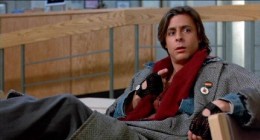How Burnouts Became Slackers Became Mainstream

John Hughes was never my guy, not really. As much as I was charmed by Ferris Bueller and drawn to the sad-eyed John Cusack of Say Anything, I was unmoved by The Breakfast Club and actively weirded out by Sixteen Candles. Pretty in Pink I don’t even remember.
In many ways, his movies defined the youth of the contentious, complicated 80s; so it is appropriate that it was he who declared that the simmering rage of the 80s was over and it was time for us all to fall in line behind the less intellectual, slapstick-y, affluent-white-boy centric blockbuster comedy of Home Alone (1990). What is the thesis of Home Alone, after all, if not that the rich should protect their advantages against interlopers at all costs?
The decade he helped usher in was not terribly kind to John Hughes. The unhinged genius behind Planes, Trains, and Automobiles went on to write Flubber, Home Alone 4 (TV movie), and the story of Maid in Manhattan.
Jason Diamond will explain it all to me in his upcoming book, I’m sure, but until then we can engage with the cultural history presented by Hayley Krischer in her essay for TPM’s Slice called “Before Billionaires Wore Hoodies: The Forgotten History of 80’s Burnouts.”
Burnouts symbolized the ’80s cultural split between the adult middle class and the adult working class. Whereas black families endured decades of racist mortgage policies and were essentially kept out of the suburbs, these white working class kids lived on the burbs’ peripheries and were the underclass of their high schools. They were outliers in a pre-Occupy time when wealth was nothing to be ashamed of. As America morphed into the 1990s, so did burnouts. But then they virtually disappeared in the aughts. Why? What exactly extinguished the burnouts?
Krischer argues that characters like Judd Nelson’s Bender in Breakfast Club represent the angry, disaffected, working class youth of the time period. They are outsiders, seen as threatening, dangerous, and unstable. What is feared in the 80s though is assimilated later into at least one current of the mainstream of the Kevin Smith and Richard Linklater 1990s and beyond.
Nowadays, class lines are much blurrier, and it’s reflected in our clothes. There’s a relative coolness in the working class aesthetic. It’s why we see shredded metal t-shirts in Forever 21. It’s why, while shopping in Bloomingdales the other day, I saw an $80 t-shirt with a collar so frayed that the fabric was literally hanging by a few threads. That look isn’t just ironic — it’s an infusion of class in fashion. Rich, young urbanites have been romanticizing the poor since they came on the scene in the early aughts.
Thirty years ago, things were more black and white, sartorially and otherwise. “There was no room for experimentation or artsy-ness,” Gaines says of the 1980s. “You were either good or you were bad.” The decade’s “good kids” were wearing frilly dresses and cotillions or khaki shorts like the “richie” who first called Reis O’Brien a burnout. Today’s clothes are much cheaper than they were in the ’80s and sometimes it’s hard to know the economic background of teenagers based on what they’re wearing.
She doesn’t mention it, but it’s true that middle-class suburban good girls like Angela Chase would probably not be wearing flannel and cheap-looking jeans — and hanging out with burnouts like Rayanne Graff — in My So-Called Life in the mid-90s if people like Bender hadn’t paved the way.
Another detail she omits, though, is that Bender ends up as the hero of The Breakfast Club. It is his fist with which we end the film, right? His excitement at having scored a victory, even a small pyrrhic one, that carries us out of the theater. Maybe John Hughes did as much as anyone to not merely document the class discomfort of the 80s but, for better or for worse, to defang it, to normalize and integrate it into the mainstream.
Support The Billfold
The Billfold continues to exist thanks to support from our readers. Help us continue to do our work by making a monthly pledge on Patreon or a one-time-only contribution through PayPal.
Comments